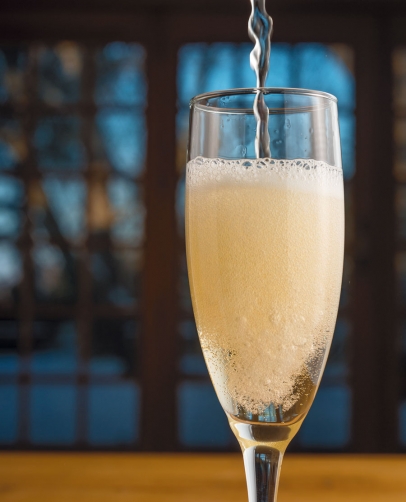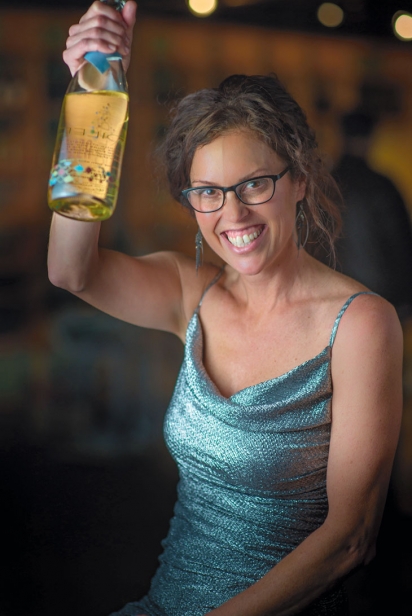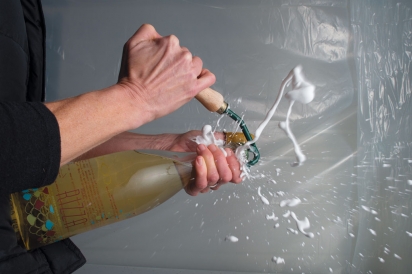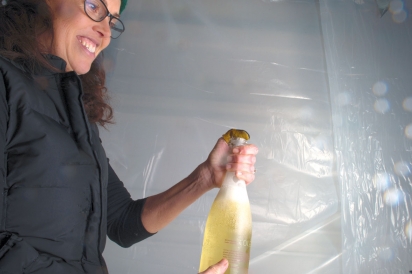Fizzy Rizza: Coiled Wines Releases Sparkling Riesling
The only thing that sparkled more than Coiled Wines’ Rizza at its debut party in December was winemaker Leslie Preston. And it wasn’t just her sequined dress. It had been a crazy few months for Preston and she had every reason to shine. Preston nailed her first attempt at making a sparkling Riesling utilizing méthode champenoise, the arduous and expensive process whereby wine undergoes a secondary fermentation in the bottle.
“This wine is made exclusively from the Riesling grape, a dear love of mine and an absolute treasure of Idaho,” explained Preston. “The Australians have great respect for this grape and lovingly call it ‘Rizza.’ I instantly adored this endearing nickname and adopted it for my bubbles.”
It all started when Coiled Business Manager Kelly Marx had an idea. As a lover of Preston’s signature dry Riesling and also of sparkling wines, Marx thought it was natural that the two be combined. Preston didn’t share this enthusiasm—initially.
“I was reluctant to tackle a wine I love so much,” said Preston. “Some things are simply meant to be enjoyed. I drink a lot of sparkling wine and I did not want to forever approach them with a critical winemaking eye.”
Making sparkling wine, besides being a very precise process, is also expensive. The yeast can cost up to five times as much as regular wine yeast and even the bottles often cost twice as much—needing to be thicker to handle the pressure of carbonation. Also, it’s a whole lot more work.
But once she was committed, Preston jumped right in. She began with extensive research, talking to brewers with experience in carbonation and experts at her alma mater, University of California, Davis. Preston harvested the Riesling grapes in mid-September and 900 gallons of juice went into stainless steel tanks to begin fermentation. Over a month later, she blended the fermented juice with 190 pounds of cane sugar, then painstakingly added an exact dose of yeast by hand to each bottle before capping it. Preston patiently waited for the wine to ferment to dryness, a process that took seven weeks.
“Our turnaround time was crazy because it’s a Riesling,” said Preston. “I needed to get it off the yeast so that the fruit would really shine through.”
Getting it off the yeast involves disgorgement, a traditional process used in Champagne production for centuries. The bottles are chilled and inverted so that the yeast collects in the neck. Slowly the bottle is tipped upright as the cap is pried off. In one quick (and hopefully smooth) move, the pressure of the carbonation sends the yeast flying out, while the disgorger’s thumb quickly clamps down on the lip of the bottle to keep wine from spraying out. Hand disgorging is wet, tiring work and a heartbreaking 30% of the wine in a bottle can be lost.
To make up for this lost wine, a liquid mixture called a dosage is added back into the bottles before they’re re-capped. The dosage, in this case, was a mixture of Coiled’s 2013 Riesling and sugar, which weaved its way into the bottle with lava lamp–style effects. The dosage is an important step in balancing out the wine’s acidity and determining the finished product’s category of sweetness—extra brut, brut, extra dry, demi-sec, etc. Preston had to repeat this time-consuming disgorgement and dosage process on a total of 4,000 bottles.
This isn’t the first time sparkling wine has been made in Idaho using méthode champ-enoise. Camas Prairie Winery in Moscow currently has several offerings made in this style, ranging from extra dry to sweet, from red to white. Established in 1983, Camas Prairie has been making sparkling wines since 1994, according to winemaker Jeremy Ritter. The winery uses Lemberger grapes for its sparkling red variety and blends various varietals, including Chardonnay, Pinot Gris, Riesling and Muscat for its white offerings.
Idaho winemaker Neil Glancey has utilized both techniques for his sparkling wines— méthode traditionnelle for the Chardonnay-based sparkler that he made at Woodriver Cellars in 2008 and the Charmat method, where the second fermentation takes place in a steel tank rather than in a bottle, for his current offering, Bubbles, a 2012 sparkling brut Riesling that was released last year on the Crossings Winery label.
After all the long days, stress and lost nights of sleep, it seemed like maybe it was too early to ask Preston if there’d be a 2015 release of Rizza, but a twinkle in her eye said otherwise.
“We will do it again,” Preston responded confidently. “I’m really happy with the wine and we’ve learned so much about streamlining the process. I’m such a proud Riesling producer I’ve just got to shout it out in bubbles!”








